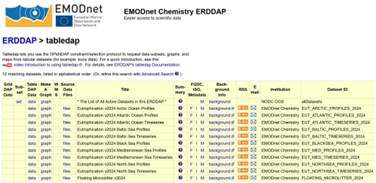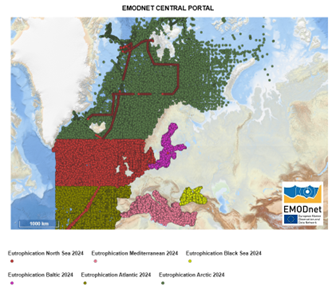Building on the existing data and web services, EMODnet’s Chemistry offer of aggregated, harmonised and validated datasets on many marine chemistry parameters e.g., eutrophication and ocean acidification (first made available in 2024) are now also available through the Environmental Research Division Data Access Program (ERDDAP™; (see EMODnet Technical blog), covering the Baltic Sea, Greater North Sea and Northeast Atlantic, Mediterranean Sea, Black Sea, and Arctic Ocean.
The latest edition of the EMODnet Chemistry data collections on ocean eutrophication and acidification are now also available via an ERDDAP installation with oceanographic data at erddap.emodnet-chemistry.eu.
ERDDAP was first produced and used by the National Oceanic and Atmospheric Administration (NOAA) for visualisation and data conversion tools that allow multiple data subsets from different sources to be merged into a single workspace. EMODnet was an early adopter for ERDDAP in Europe, and from 2023 all thematics of EMODnet offer some ERDDAP services.
In its latest release, EMODnet’s ocean eutrophication and acidification data collections are now available through ERDDAP. In the last ten years, the use of ERDDAP has evolved from a software tool developed and used by NOAA to a central instrument for around 100 organisations in at least 16 countries. It is based on the OPeNDAP standard and allows users to download subsets of scientific datasets in common file formats and to create diagrams and maps. ERDDAP offers both a human-readable and machine-readable approach, thanks to its easy-to-browse web pages and web services for computer programmes.
As shown in Figure 1, the EMODnet Chemistry ERDDAP data collection contains 11 datasets listed in alphabeticalorder. They are organised in vertical profiles and time series covering one of the following marine regions: Arctic Ocean, Baltic Sea, Greater North Sea, Northeast Atlantic, Mediterranean Sea and Black Sea. Vertical profiles are data collected at approximately the same time and location for several consecutive vertical depths, while time series are data collected at the same location and depth but repeated in time.

Figure 1. EMODnet Chemistry Ocean eutrophication and acidification datasets at erddap.emodnet-chemistry.eu©EMODnet Chemistry
The regional data collections now available via ERDDAP were first published in 2024. The collections are based on the unrestricted measurement data gathered in the SeaDataNet Data Discovery and Access Service and then delivered to six Regional Coordinators (RCs) via an automated robot harvester. The RCs strive to create the data collections by aggregating, harmonising and regularly validating new data sets from dozens of data centres, which in turn collect data from hundreds of originators.
OGS, the coordinating institute for EMODnet Chemistry, together with Chemistry partners has used the 2024 edition of the regional ocean acidification and eutrophication data collections to develop tools and scripts that enable a standardised workflow for ERDDAP dataset creation and metadata review. In addition, new layers have been published in the EMODnet Map Viewer showing the spatial distribution of the sampling stations contained in the above-mentioned data collections (Figure 2).

Figure 2. The new layers in the EMODnet Map Viewer showing the spatial distribution of the sampling stations included in the aggregated, harmonised and validated ocean eutrophication and acidification datasets. ©EMODnet Chemistry
The institute is currently working on making all other collections accessible to ERDDAP, namely the data collections for microlitter, beach litter, seafloor litter and contaminants. Finally, the OGS is analysing the performance of the ERDDAP endpoint to optimise its user-friendliness.
“With this implementation, EMODnet Chemistry aggregated datasets are now interoperable contributing to increasing the FAIRness of the data.” Sebastian Plehan, National Institute of Oceanography and Applied Geophysics-OGS
